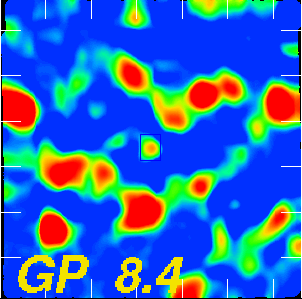


| (a) | loading image processing software |
| (b) | loading required FITS images |
| (c) | galactic coordinate system |
| (d) | Intensity vs frequency relationship |
| (e) | mathematical analysis |
The region of interest for the first data analysis is the Cygnus region of the Milky Way. The Cygnus region is one of the spiral arms of our galaxy and is rich in its variety of radio sources.
Review the instructions in Introduction to Image Processing.
| 1. | Load Sky Image Processor (SIP) program. |
| 2. | Load FILE cyg-xcal.fit. |
To access the Sky Image Processing program, connect to: http:// http://www.phys.vt.edu/~jhs/SIP/
In your data table, record the following information:
Galactic coordinates of source; Sum of pixels per box at each of the two observed frequencies;
| 1. | GALACTIC COORDINATES: [LONGITUDE] [LATITUDE] |
| 2. | SUM OF PIXELS/BOX for both [8.35 GHz image] and [14.35 GHz image] |
| 3. | RATIO OF SUM OF PIXELS/BOX: [8.35 GHz/14.35 GHz] |
| 4. | MAX/BOX: [14.35 GHz] |
| 5. | INTENSITY: [14.35 GHz] |
| 1. |
The equation shown above will calculate the object flux of each source.
Variables used from [SIP] are:
ObFl = object flux; related to source intensity SumPixBox [freq] = sum of pixels/box at a given frequency MaxBox [freq] = maximum in box at current frequency; related to source brightness ObFl=((SumPixBox @ 8.35 GHz)/(SumPixBox @ 14.35 GHz))*(MaxBox) |
| 2. | From your data of the Cygnus X3 region, what is the number of thermal sources found? |
| 3. | From your data of the Cygnus region, what is the number of supernova remnants found? |
| 4. | In an area of 10 by 10 degrees centered on Cygnus X3, use your data of (1) and (2) above to calculate the number of thermal and non-thermal sources per unit area. Do this calculation for both frequencies. This calculation shows the distribution of sources in the Cygnus arm. |
| 5. | Create a graph with INTENSITY on the y-axis and FREQUENCY on the x-axis. Use this graph to plot your intensity vs frequency data for each source. Use a scheme of different colors or different shapes to identify each source. |
| 6. | Print a map (hard-copy) of the 10 by 10 degree region of Cygnus X3. On your map, use your data table to locate and record the type of object: thermal or supernova remnant. You have now identified certain characteristics of the Cygnus arm of the Milky Way. |
| 7. | Does your graph of INTENSITY vs FREQUENCY agree with theory? Explain your answer. |
In your next exercise, you will calculate the angular size of each source.
|
|
|
|
| Previous | Up | Next |